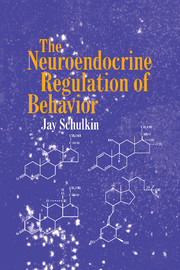Book contents
- Frontmatter
- Contents
- Acknowledgments
- Introduction
- 1 Hormones, Development, and Sexual Dimorphic Behaviors
- 2 Hormonal Regulation of Sodium and Water Ingestion
- 3 Hormonal Regulation of Food Selection
- 4 Hormones, Parental Care, and Attachment Behaviors
- 5 Hormonal Regulation of Fear and Stress
- 6 Hormones, Behavior, and Biological Clocks
- Conclusion
- References
- Name Index
- Subject Index
4 - Hormones, Parental Care, and Attachment Behaviors
Published online by Cambridge University Press: 25 January 2011
- Frontmatter
- Contents
- Acknowledgments
- Introduction
- 1 Hormones, Development, and Sexual Dimorphic Behaviors
- 2 Hormonal Regulation of Sodium and Water Ingestion
- 3 Hormonal Regulation of Food Selection
- 4 Hormones, Parental Care, and Attachment Behaviors
- 5 Hormonal Regulation of Fear and Stress
- 6 Hormones, Behavior, and Biological Clocks
- Conclusion
- References
- Name Index
- Subject Index
Summary
Introduction
Animals like ourselves seek attachment and security during development. A number of hormones underlie and help facilitate attachment behaviors and the distress behaviors that result from loss of attachment and security. Hormones facilitate the attachment behaviors of parents toward their young and the young toward their parents. Although this has been demonstrated for only a few species, most of us in the field think that eventually the phenomenon will be observed in most animal species in which there is parental investment and long-term bonding during development.
There are clear differences between the two major traditions of thought regarding endocrinology and the regulation of behavior. The scientific tradition in which I have been educated is that of Bernard, Cannon, and Richter, described at the end of Chapter 2. We are accustomed to thinking of bodily alterations and hormonal activation and regulation as being brought about by both physiological and behavioral means. The tradition that emanates from Bernard, Cannon, and Richter looks at the inside of the animal: that is, how changes in the internal milieu generate both physiological responses and then behavioral compensatory responses to provide stability.
But there is another rich tradition, as relevant as the Richter tradition. It emphasizes social facilitation in the regulation of the internal milieu (e.g., Levine, Chamoux, and Wiener, 1991), a view championed by Lehrman and Friedman (1968) and Hinde and Stevenson (1970).
- Type
- Chapter
- Information
- The Neuroendocrine Regulation of Behavior , pp. 116 - 144Publisher: Cambridge University PressPrint publication year: 1998



